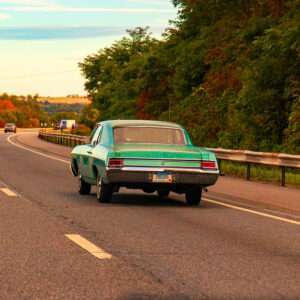I don’t mean to brag but I’m kind of an expert road trip co-pilot. My husband and I make almost all of the trips we take together via car. Actually, of all the trips we’ve taken together, only one was not by car. He’s a bit fearful of flying, and I don’t really blame him.
Road trips are long and boring and hard on your body. But they’re also fun and exciting and it’s a wonderful way to at least learn what the landscape is like all over the country. Spoiler alert, there are a lot of farms and cows next to the interstate.
There are a lot of variables to consider when planning for your multi-day road trip. This article is going to discuss what I’ve discovered to be best practices in planning and preparing for a road trip like this. Every trip is different, so feel free to riff off of this. The only thing I can tell you without a doubt is that the best parts of the road trip are when you reach your first destination, and the last one. Home.
How far is your trip? How far can you go in a day?

The first thing you need to figure out is how far your trip is total, and how far you can go in a day or in a certain number of hours. For this trip, our drive out was a little over two thousand miles, or about 30 hours driving.
In my experience, a 30-hour drive needs to be split up over 3 days. Especially if only one person is driving or if no drivers are that comfortable driving at night. I also know that for every 12 hours of driving, you will need to add another hour to an hour and a half for stopping for gas, stretching your legs, and getting one decent meal.
How far you can get in 12 hours depends on where you are in the country. If you’re out anywhere from Nevada to Ohio, 12 hours is going to get you pretty far. The speed limit is a lot faster out on i70 in Kansas than it is on i90 in western Mass.
Usually, I’ll plan out the full route in Google Maps, and then break it up into however many parts makes the most sense for us. I zoom into the map to about where I think the break is and look for a decent sized town. Then remap my route from my starting point to that first city, then from there to the next, and so on. It takes a few tries and some research. I want to ensure that wherever we’re headed will have plenty of hotel options without having to stray too far from the interstate.
For example, for this trip, we traveled from Colorado Springs to Southern New Hampshire. Since I was well aware of both mine and my husband’s needs and limitations, I knew that two 12 hour days and a 6 hours day was more than doable. We decided to leave in the afternoon after work and knock the 6 hour day out of the way. That put us in Salina, Kansas. We split the remainder of the drive in half. 12 hours (831 miles) in the car the next day to just outside of Columbus, Ohio. And another 12 hours (798 miles) from there to New Hampshire.
As far as hotels go, I always research the options using the Orbitz app, but I won’t book until we’re an hour or two away because things can happen on the road. 800 miles is a long way and there is always the chance you might not make it to your stop. Like, one time, we drove out to NH to pick up my cat who I’d left behind when I first moved to Colorado in 2011. We thought we could make it home to Colorado in two days. My husband was like, “Fuck it, I can drive for 16 hours.” We were a little under 300 miles from home near the border of Nebraska and Colorado when the cat was like, “I can’t make it 16 hours you dumb assholes.” And he peed all over Geoff’s newly leased BMW.
On the upside, there’s also a chance that you make a better time than you expect and there’s another city in the next 70 miles with more hotel options. If you stick to the interstate, you’ll find plenty of options for hotels nearby your exit, as long as you’re aware of where the larger towns are along your route.
How to pack
I prefer to be prepared all the time. My husband makes fun of me but I’ve saved the day with my corkscrew and purse lighter on more than one occasion (including on this road trip). However, I don’t like to carry heavy things so I’m careful in my preparation.
I had to pack a large suitcase because I wanted to make sure I had the right clothing for anything the weather threw at us. October in a lot of the United States can bring unexpected early snow or summer-like hot temps, sometimes in the same city.
I decided to pack my large suitcase with all of the clothes, shoes, and coats I might need during our trip. I brought 6 pairs of shoes, only one pair didn’t get worn. I needed my running sneakers for the race, and my Doc Marten boots for the hiking we planned to do in Tennessee. The other three pairs were a pair of ankle booties, Van slip
Honestly, if it hadn’t been for all the shoe requirements, I probably could have downsized my suitcase.
In order to make the quick hotel stops on the way out and home easier to deal with, I also packed my small “personal item” sized duffel bag. In there I packed all of our toiletries, makeup/skincare, some clean clothes, and chargers for our phones and vapes. This made the entire hotel stay so much less stressful. First, we weren’t lugging a bunch of stuff into the hotel just for one night. Second, we didn’t have to deal with the stress of “did we get everything out of the hotel” the next morning.
Usually, we’d bring our cooler inside too to swap out the ice and drain the water, but we got lucky it was cool enough outside and we weren’t carrying anything that would spoil if it got too warm.
If your initial destination is going to require a night or more in a hotel just to get there, I strongly suggest using a “carryon” to get you through those short stays.
What food to bring

This was the first trip that we brought just the right amount and the right kind of snacks for the car. In the past, I’ve tried to bring deli meat and bread and produce and large “value” sized chips and crackers. Like we’re leaving for a year and might not get to eat again. You know what happens when you bring too much, or too impractical food? It goes bad and you have to throw it away.
This trip, I decided to go with less. We brought a large cooler for some cold drinks and cheese. Also, we knew we’d probably leave my father-in-law’s house with as much frozen corn as we could fit. But most of the snacks we brought were shelf stable. I also brought some food in anticipation of our Airbnb in Tennessee, that was all shelf stable, too.
I decided that if we really need something on the road, we’ll just have to buy it. There are grocery stores in all of our destinations, and convenience stores every few miles between here and there. We’ll survive if I don’t bring a pound of sliced deli turkey.
Here’s a list of what we brought and why:
- Beef jerky – we like meat and it’s easy to eat in the car as a driver
- Cooked bacon – I cook two pounds every week or two for us to heat up for breakfast. There happened to be four pieces left so I tossed them in a bag to eat in the car. Not sure if it’s ok to eat cold but it tasted great.
- Baby Bel wrapped soft cheese – I’m not going one day without cheese and these are great because even if they end up swimming in your cooler, the wax protects them and you can still eat it.
- Variety pack of single serve Nabisco snacks – these were for my husband mostly. He loves cookies and this giant box I picked up at Costco was perfect. He’d just pull out a few little bags for the back seat and then the box remained in the trunk, safe from accidental crushing.
- Jar of peanut butter – peanut butter is life.
- My favorite tortillas – I brought these for the peanut butter and to put scrambled eggs and cheese on for breakfasts.
- Candy – first of all, who doesn’t bring candy on a road trip? My husband regularly buys boxes of full-size candy bars from Costco, so it was a no-brainer.
How to be a good co-pilot
My husband does all of the driving on our road trips because I actually don’t have a driver’s license (I didn’t need it in Boston and it was cheaper to just get an ID and now it’s been 11 years and I need to retake my test). Since he’s doing the hard work, I make sure to be the best co-pilot possible.
How do I accomplish that? I start by making sure I can reach all of the food the driver might need. I also make sure that my purse has anything one might need in the car. From hand sanitizer to ibuprofen to a spare phone charging cable.
I also try to keep an eye on time and the speed at which we are traveling to estimate when and where we might make our next stops for dinner, gas, and to stretch our legs. And then input those stops into our navigation app when necessary. To be honest, most everything you need on the road can be found without needing navigation if you follow the signs on and off the interstate.
Essential apps
 There are three apps that made this trip a little easier.
There are three apps that made this trip a little easier.
First, the navigation app we used, Waze, is absolutely essential. It will warn you when there’s traffic and give you an estimated time in traffic. Alert you to police, debris, and closed lanes. It’ll even divert you out of the path of traffic if and when it can.
The next app we get a lot of use out of is Roadtrippers. You can input your trip and it will find you a route and give you tons of options for stops along the way. Whether you’re looking for some local food or some weird ass giant ball of yarn, you’ll get that information on Roadtrippers. I generally use it to find food. On other trips we’ve found some weird little local places to eat at. This trip we weren’t as fortunate and ended up indulging in a lot of casual chain restaurants, but it was still helpful.
Finally, there was Orbitz. I love the search and sorting functionality of the app. I don’t always book through the app itself, but it was helpful to see what the options were in each of the cities we planned to stop in. Plus the reviews are helpful and you can see options on a map so you can choose one close to the interstate.
I made a mistake not to trust the reviews on our first night out and went with a La Quinta because they tend to be pretty consistent and my family long been loyal to La Quinta. We ended up staying in a hotel that smelled a little like a freshly shampooed dog. It wasn’t the worst thing in the world, it was just old and needed updating as the reviews said. On the way back, we stayed in the same city but opted for a higher rated hotel. We stayed at a much nicer and newer La Quinta the second night and were completely comfortable (and no wet dog smell).
These are all of my best tips and tricks for making the planning of your road trip a breeze. I’d love to hear what kind of tips you have or what you’ve done to make your road trips easier. Leave a comment below or send me an email.




